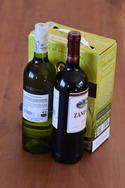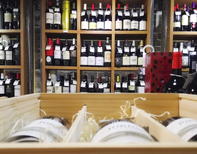Wine is Wine

Although boxed wine is often seen as the cheaper alternative and occasional saviour for poor students who can’t afford the ‘good stuff’, it is not necessarily a second-class beverage, simply packaged differently to bottled wine.
There are different pros and cons for either type of container, depending on the occasion and your budget.
Quantity versus Tradition

Traditionally wine was bottled in glass and sealed with cork and covered with lead. More recently, cork closures have been replaced with plastic and metal screwtop closures. While these are more effective at sealing wine from a food safety perspective, the traditionalists still yearn for the cork sealed wine bottle. There is a shortage of cork worldwide and cork stoppers are very costly. Also, who still has corkscrews in their home?
Boxed wine is also a packaging development. It facilitates selling wine in a more affordable packaging as well as selling wine in larger quantities that in a glass bottle. While boxed wine is thus generally cheaper than bottled wine per litre, the difference in price is due to the packaging, not necessarily the quality of the wine. Many cellars sell the same wine in both bottles and boxes.
However, as boxed wine is the more affordable option, the general trend is that boxed wine tends to serve more of the cheap and cheerful market than bottled wine, which is more expensive and thus perceived as a classier option.
The bulk buy that boxed wine is usually a four to five litre packaging and comes with the delightful promise of lasting longer that the single bottle of wine. Boxed wine is lighter on your pocket and the tap certainly comes in handy when you’re pouring your fifth glass of vino.The original stigma attached to boxed wine has faded over time as the vacuum-packaging of boxed wine prevents oxidation and preserves wine for much longer than bottled wine once it has been opened.
Bottled wine is often allowed more time to age than box wine. This will mean that a Shiraz bottle and box of the same vintage will most likely be the same colour but not taste the same, for various reasons. With bottled wine, there is an interaction between the wine and the cork which contributes to the flavour and if the cork is has tainted the wine by allowing oxidation, it can entirely spoil the flavour. It can be very disappointing to pull the cork on an aged bottle of wine, only to find that this superior wine now tastes like mouldy vinegar. With boxed wine, however, the taste will automatically vary from bottled wine with cork closures as its packaging does not contribute to its taste.
Thus, the taste profile between bottled and boxed wine is likely to differ. Consumers have the choice to decide between the two types of packaging based on their needs, preference and budget.
Nitpicking the Packaging

Bottled wine is much easier to transport in a cooler to a function than a box. You can mix and match if you and your partner have different tastes in wine. Depending on the size of the function and the thirst of those attending the function, arriving with a bulky box of wine might make you the hero of the hour!
For all the sustainable-living gurus out there, boxed wine is more environmentally friendly than bottled wine. Opt for the box if you care about this and are willing to wash the plastic bag and recycle the bag and the box.
Whether you enjoy your favourite Chardonnay bottled or boxed, it really makes very little difference. Be thankful that as a consumer you have various options and focus on appreciating the content of the packaging. After all, enjoying the wine is the object of the exercise.